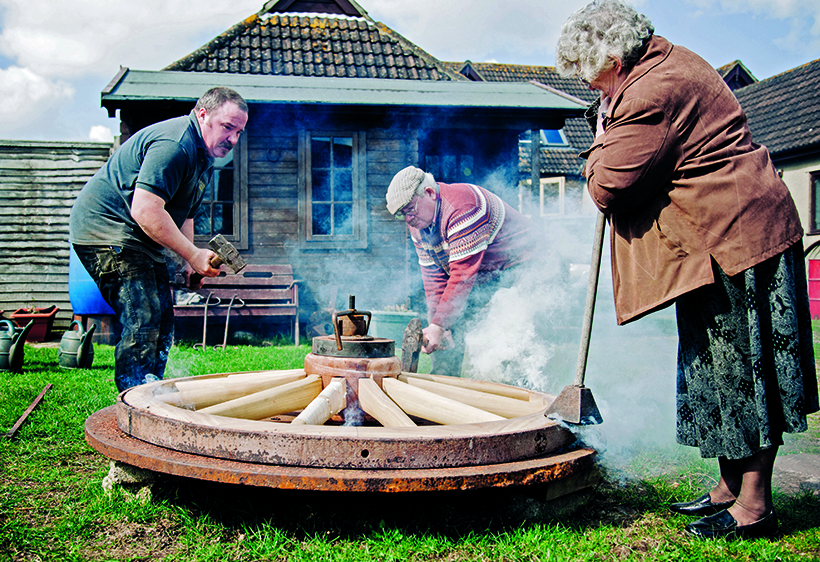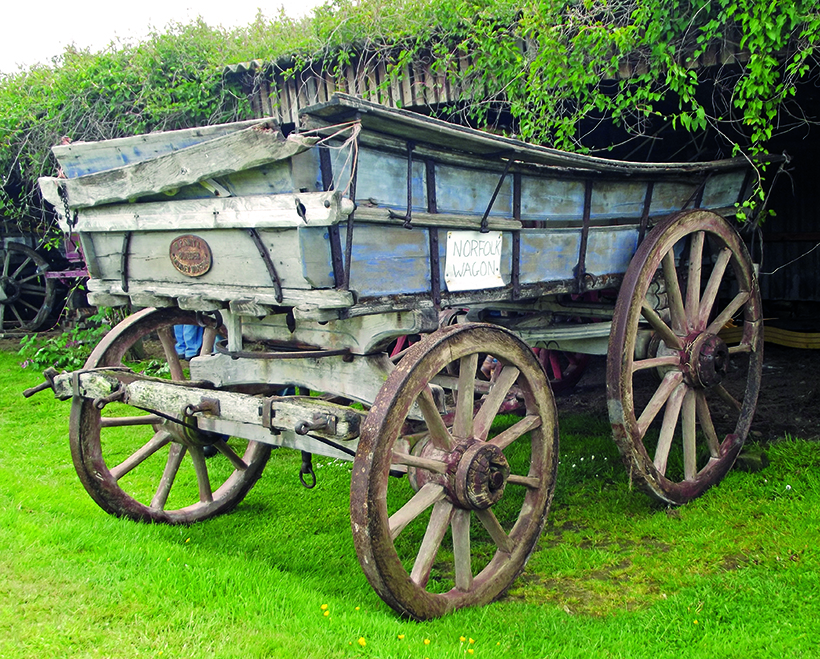Craft of the wheelwright
Posted by Chris Graham on 19th December 2020
The ancient craft of the wheelwright goes back to prehistoric times, as Jo Roberts discovers.

Craft of the wheelwright: Greg Rowland and his parents fitting a metal tyre on to a newly-made cartwheel at their Mike Rowland & Son Wheelwrights and Coachbuilders workshop in Devon. (Pic: Greg Rowland)
The earliest wheels were made from simple, solid disks, shaped from a single block of wood. From around 5,000BC, people were making wheels from three, shaped planks of wood, but these were heavy and had weak spots. From around 2,000BC, spoked wheels started appearing and, by the Iron Age, these improved wooden wheels were being fitted with iron ‘tyres’. Some of these ‘tyres’ were simply short strips of iron called strakes, which helped to hold the joints of the felloes together, and which protected the wooden wheel from wear.
Shoeing the wheel
Nailing the strips of iron on to the wheel was known as ‘shoeing’ the wheel. Gradually, designs developed to include a wheel rim made with wooden, sectional felloes, and a one-piece hoop tyre. This is the wheel we still see today, fitted to antique, horse-drawn wagons.
Traditionally, a wooden cartwheel is made from three different types of wood; the ‘nave’ or hub was constructed from elm, which had tough grain and was unlikely to split. The nave would often be strengthened further by adding iron bands, which were heated-up and fitted by a blacksmith. The spokes were usually made from oak, and the felloes – the curved sections that form the outside of the wheel – were typically made from ash. These woods had to be perfectly seasoned to avoid the risk of both cracking and warping and, with this in mind, timber was sometimes seasoned for up to six years before it was used.
The final stage of making a wheel involved the fabrication of the iron ‘tyre’ that fitted around the outside of the wheel. This, like the fitting of the hub bands, was a job for the blacksmith who, when cart-building, worked closely with the wheelwright.
The wheel and the iron hoop that formed the tyre, had to be precisely measured, so the hoop was the correct size for the wheel. The iron hoop was fitted when hot and, as it cooled, it contracted to hold the wheel together.
Wheelwrights not only made cartwheels, they often built and repaired carts and wooden implements, with the blacksmith providing any metal fittings that were required. Consequently, tt made sense for a wheelwright to set up business close to the blacksmith, as both craftsmen might frequently be called upon to work together.

One of the carts from Norman Frost’s fine collection.
Shaper of wood
The word ‘wright’ comes from an Old English word ‘wryhta’ which means a worker or shaper of wood, and is seen in words like ‘wheelwright’ and ‘shipwright’, and in surnames like Wright and Cartwright.
In the 19th century, there was a wheelwright in almost every community, and they were essential for the movement of goods and people as well as playing an important role in agriculture. With the arrival of motor cars, lorries and tractors, work gradually slowed down for the wheelwrights, and many moved over into engineering roles and, as some older wheelwrights died out, their knowledge and skills frequently went with them.
Today there are very few working wheelwrights, but the craft has not altogether died out, as there remains a need for traditionally-made cartwheels. So, the modern wheelwright’s work comes from owners of antique and vintage vehicles, and from the military and the Royal Family, both of whom have large and widely varying ranges of antique horse-drawn ceremonial vehicles.
For a money-saving subscription to Tractor & Farming Heritage magazine, simply click here





